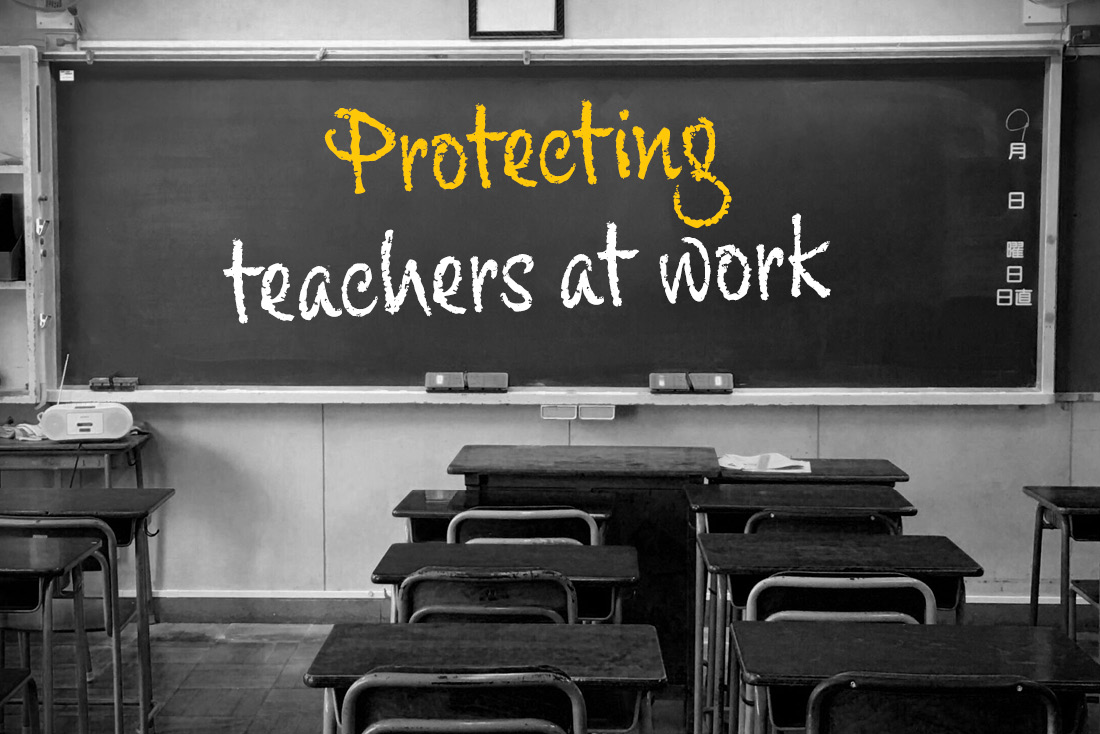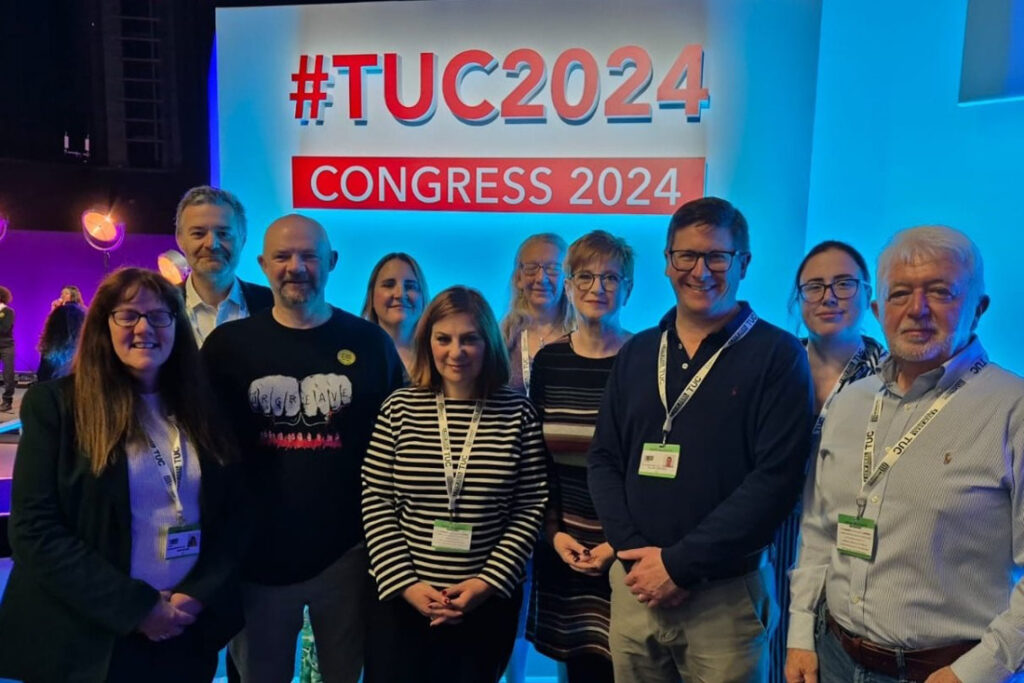
The EIS played an active part at this year’s Trades Union Congress in Brighton. The EIS delegation was led by President Allan Crosbie, who moved a major composite motion on protecting employees in their place of work. General Secretary Andrea Bradley, writing in the Morning Star in the week of congress, explained why action to make schools safer for staff and students alike is absolutely vital.
While the perception may be that the primary goal of trade unions is to look after workers’ financial health by securing fair and better pay, the objective to protect the physical and mental health of members is paramount.
No worker should ever go to their place of work and be placed at unmanaged risk of physical or mental injury. However, our members – the vast majority of them women – as a result of too little investment in our education system, are increasingly at too high a risk of experiencing assault and injury in the course of their working day, and/or of poor physical and psychological illness longer term.
Unquestionably, our schools should be safe places for teachers and support staff to work, and for young people to learn. Sadly, the risk of injury and ill-health continues to be very real and growing in our schools.
Every year, the EIS compiles a report of members who have been injured in the course of their work, and every year it makes for grim reading. Injuries caused by slips, trips and falls still occur far too frequently in our schools, yet could often be avoided through adequate risk assessments and correct adherence to health and safety guidelines.
Unquestionably, our schools should be safe places for teachers and support staff to work, and for young people to learn. Sadly, the risk of injury and ill-health continues to be very real and growing in our schools.
Poorly maintained buildings and equipment also pose a significant risk to those working in schools. Many school buildings are at or past their intended service-life and require substantial investment to bring them up to standard. The presence of Asbestos remains a serious issue in many school buildings, and one which requires to be managed with extreme care.
Recently, the risks associated with Reinforced Autoclaved Aerated Concrete (RAAC) hit the headlines, with schools across the UK potentially at risk of RAAC collapse.
Problems are not just limited to older school buildings, however. In their haste to replace some older buildings, government and local authorities have sometimes entered into arrangements with private providers to build and maintain schools. While this has delivered many new buildings, it has often come at the expense of quality facilities – cheaper options chosen to keep costs down and boost profits, with the consequence of potential diminution of health and safety standards.
The Covid pandemic highlighted the particular challenge of ensuring clean air within school buildings. With relatively small classroom spaces containing upwards of 30 people, the potential for the airborne spread of infection is significant.
The use of High Efficiency Particulate Air (HEPA) filters can help to mitigate the risk, but only a small number of schools have such devices fitted because of the costs involved. Investment is urgently needed in this area, to ensure clean air in classrooms and to protect the health and safety of staff and students.
From school buildings to staffing levels, significantly more investment is needed if schools are to be the safe learning spaces that we want and need
All in all, the poor physical state of many of our school buildings is a sobering metaphor for the unhealthy state of resourcing to education – a vital public service that is being steadily starved of resource. From school buildings to staffing levels, significantly more investment is needed if schools are to be the safe learning spaces that we want and need, and that health and safety legislation demands.
Another deeply troubling issue is the serious and growing problem of violence against teachers and other staff in schools. Sadly, in most schools both verbal and physical attacks on school staff are now a fact of life, with 83% of respondents in a recent EIS survey stating that violence and aggression against staff happens every week in their school.
72% of respondents in that same survey indicated that the problem has grown worse in recent years, and is now significantly worse than it was before the Covid pandemic. During this period, a significant number of young people experienced serious difficulties with disconnection from education, their peers and their teachers, and this, coupled with a societal mental health crisis and years of austerity, has resulted in a growth in challenging behaviours, including aggressive and violent behaviour, amongst a significant minority of young people.
As a complex issue with deep societal roots which must be factored into possible solutions, it is not simply the case that these are “bad children”, but young people facing serious challenges, often linked to poverty and deprivation, in their everyday lives.
While schools will do all that they can to support young people whose lives are being wrecked by poverty, and doing so with grossly insufficient staffing levels and specialist resource, the issues that these young people face neither begin nor end at the school gate.
Within schools, the specialist resources to support young people experiencing difficulties have been pared to the bone. The loss of specialist Additional Support Needs (ASN) staff across the country is a painful result of swingeing cuts to education provision, increasing the demands on already overburdened class teachers and reducing the support network for some of the country’s most vulnerable young people.
In bringing our motion on Protecting the health, safety and wellbeing of school staff to this year’s Trade Union Congress, the EIS hoped to shine a light on all of these issues and place greater pressure on the UK and Scottish governments, and local authorities to act. Education provides a wonderful opportunity for young people to learn and to thrive, but this can only be achieved in an environment where students can feel safe and be safe, and where the health, safety and wellbeing of teachers and fellow members of school staff is protected as a priority.
– A version of this article was originally published in the Morning Star
EIS at TUC

EIS delegates spoke on a range of motions at this year’s Congress, making important contributions to key debates.
President Allan Crosbie moved composite motion 14, on protecting employees in their place of work. In his speech, based around the need to ensure a healthy and safe working environment in all schools, Allan said, “The fact is that Covid hasn’t gone away, and its effects on staff in all education sectors is a real concern. We are second only to our comrades in the health service when it comes to the risks of contracting Covid within the workplace.
But we already know that this is preventable, because studies have repeatedly shown that cleaning the air can significantly reduce Covid outbreaks in schools. This is why we are calling on the TUC to campaign for HEPA filters to be fitted in every indoor learning space.”
Ex-President Paula McEwan moved composite motion 1, on ending the hostile environment towards workers and unions. Addressing Congress, Ms McEwan said, “The size and scale of the devastation wreaked on workers and their families and communities over the past decade and a half mean that there’s not a minute to waste in us mounting a comprehensive programme of rebuilding and restoration of workers’ rights and their living standards.
Public Services in Scotland and across the UK are in crisis. 14 years of Tory austerity politics have squeezed the life out of them
Now, with a Labour Prime Minister in Downing Street with a significant majority, we must keep up the pressure so that we see an immediate end to the hostile environment towards workers that we have felt so acutely since 2010.”
Vice-President Adam Sutcliffe spoke in support of composite motion 11, on protecting public services, and said, “Public Services in Scotland and across the UK are in crisis. 14 years of Tory austerity politics have squeezed the life out of them. Scotland’s teachers, along with public servants across these islands, are overworked.
“The workload burden is leaving teachers stressed within all aspects of their lives, not just work. Education is one of the bedrocks of society, yet it appears to be easy to slash funds. Fund quality public services and Stand up for Quality Education.”
You can view video of these speeches to Congress at www.youtube.com/@EISunion or on the EIS website at www.eis.org.uk/latestnews/tucspeeches
